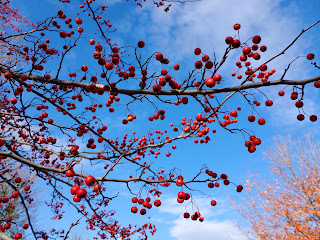Rochelle Owens is writing a multi-part poem, “Patterns of Animus,” which may, at the end of the day, be long enough for a book. Owens, who has been a part of the poetry vanguard since the 1950s, is still producing innovative, philosophical, subversive work.
 |
| Susan Nash and Rochelle Owens, November 2021 |
Patterns of Animus Part 4 Carnal / Spiritual takes quotes from Dostoyevsky ("How can you live and have no story to tell?") and the presence of a cosmic-level tapeworm as points of departure; together they posit an alternative mechanism for the functions of the universe. Instead of constantly expanding and growing, Owens introduces the notion of the tapeworm. It’s interesting to think of the universe dominated by a tapeworm mechanism: parasitically feeding off the energy of its host, and ultimately killing the host (and thus, that part of the cosmos, or perhaps all of it) a postulated end of time, end of the universe. The tapeworm is greedy, eternally hungry, and ultimately grows to enormous size and length in the gut of its host.
It's not unusual to see an ouroboros in literature, especially Medieval and Renaissance literature, where the snake swallowing its tail causes the snake to metamorphose into another snake with completely different patterns and aspect. The ouroboros had symbolic significance in Ancient Egypt and denoted the transmigration of souls. For medieval and Renaissance writers who delved into topics of alchemy and mystical practices, the ouroboros represented the transformation of worthless substances into gold. The tapeworm is a kind of anti-ouroboros, capable of sucking in, but instead of entering a sheltering, warm womb, nothing grows, and nothing transforms itself into something else. The tapeworm devours without producing anything except an insatiable hunger. The tapeworm eventually kills the host by completely coopting the digestive system. Anything eaten feeds the tapeworm. Nothing is left over for the pitiful and pitiable host. The image that comes to mind is of a cow in a field, ribs and hipbones protruding, looking like a skeleton draped with hide. The cow is eating grass, chewing, chewing, and chewing, trying to curb her hunger – ultimately a lethal hunger, because the more she eats, the more she feeds the tapeworm. The tapeworm would be a comfortable metaphor for consumer culture, but in Rochelle’s hands, its vaster, horror-inducing, and perfectly sublime (as described by Edmund Burke).
As an essential cosmological mechanism and unseen presence in the universe, Owens’s construction of the tapeworm opens the mind up to really intriguing (and horrific) ideas and images. First, one might say that the mechanism is appropriate – after all, we have detected the presence of black holes. What if they are simply mouths of the multiple tapeworms that riddle the universe? They suck up the energy. We have mathematically explained it with models in astrophysics that suggest that stars expand but only to a point, and then they implode. I don’t understand how the extreme gravitational pull is explained by physics. I thought one had to have a tremendous amount of mass in order to have a gravitational pull. Perhaps the mass is there, but is in a long-term process of compression and collapse, and perhaps that is what drags in the nearby “nutrients” (light, moving objects, etc.). How would that process relate to a tapeworm? A tapeworm has two orifices: the gaping mouth that ushers nutrients into its “filthy maw” (to quote Spenser in The Faerie Queene), and its back orifice, its anus. Perhaps there are eruptions in the cosmos that correlate to the tapeworm mechanism’s outpourings of waste products. I don’t know. It’s a fascinating, mind-expanding mental exercise to envision it.
In Owen’s study, next to the computer where she works on her poems, there is a window that provides a view of a corner and a lovely little tree, which Rochelle has observed with concern and outpourings of well wishes for its health. She also has a Merck’s manual which contains a lengthy entry on tapeworms.
There is an essential horror in the concept of a massive cosmic tapeworm. It makes the Dune sandworms look like Silly String. Intrusive thought - Do you remember Silly String? I don’t know if it is still being manufactured – it was something you would spray from a can, and it would come out as thin strings of plastic. I’m not sure what the entertainment value really was, but I remember being in a Silly String war. It was fun to spray over plants as a kind of decoration. It was probably toxic and highly flammable. I am just guessing, though.
I can imagine Owens’s cosmic tapeworm as a fundamental, thumpingly insistent expression of a rap song, with its dark chord progressions and even darker lyrics. The yawning, filthy mouth, the devourer of its host is actually a pretty good metaphor for the dark songs of classic 1990s group Tool as well. I don’t know what that genre of rock is called, but it definitely fills one with existential gloom, and at times, horror.
 |
| Still Life: Rochelle Owens |
 |
| A brilliantly clear day in Philadelphia |
 |
| Susan Smith Nash, photo by Rochelle Owens |